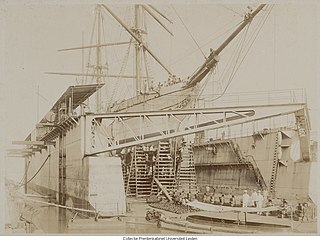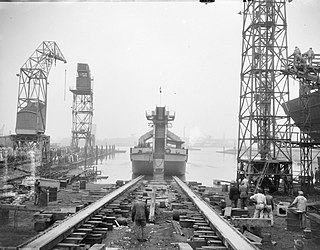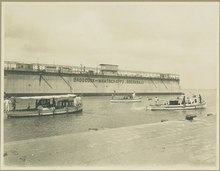
The Rotterdamsche Droogdok Maatschappij (RDM) was the largest pre-World War II shipbuilding and repair company in Rotterdam in the Netherlands, existing from 1902 to 1996. It built 355 mostly major seagoing vessels, 18 of which were submarines. During its existence, the wharf operated 12 floating docks and in its heyday employed 7,000 people at one time.

Pieter Corneliszoon Hooft was a Dutch ocean liner built in 1925. An onboard fire destroyed her passenger accommodation before she was completed. In 1932, another fire damaged her so severely that she was sold for scrapping, only to catch fire again before she was scrapped.

Wilton's Dok- en Werf Maatschappij was a Dutch shipbuilding company active as an independent company from 1854 till 1929. At first it was simply known as 'Wilton'. In 1921 the final Dutch name became: 'Wilton's Dok- en Werf Maatschappij NV', the equivalent of 'Wilton Engineering and Slipway Company'. Wilton started as a traditional smithy and expanded in machinery. It specialized in ship repairs, but also became a shipyard. At first only for fresh water ships. In spite of multiple name changes the company was commonly referred to as 'Wilton'. In 1929 a merger with Fijenoord led to a new company known as Wilton-Fijenoord.

The Nederlandsche Scheepsbouw Maatschappij, was a Dutch shipbuilding company based in Amsterdam. It existed from 1894 to 1946. From c. 1908 it was the biggest Dutch shipbuilding company.

Onrust Dock of 3,000 tons, was a floating dry dock that served in the Dutch East Indies from 1869 till at least 1933. Up till about 1910 she was a crucial part of the Dutch naval infrastructure in the Indies.

Volharding Dock, was a floating dry dock built for the Nederlands Indische Droogdok Maatschappij (NIDM) in the 1870s. It was the smallest of two unique tower dry docks, and the only one that would actually be put in use.

Batavia Dock, was a floating dry dock built for the Nederlands Indische Droogdok Maatschappij (NIDM) in the 1870s. It was the biggest of two unique tower dry docks, but would never be used.

Onrust Dock of 5,000 tons, was a floating dry dock which served in the Dutch East Indies from 1881 till 1924.

Tanjung Priok Dock of 4,000 Tons, was a floating dry dock built for Droogdok-Maatschappij Tandjong Priok in the 1890s.
Untung Jawa, previously known as Amsterdam Island is an Indonesian island off the coast of Jakarta. It is part of the Thousand Islands.
Evert Jansen was a newspaper editor, journalist and politician from the Dutch East Indies. From the 1910s to the 1940s, he was editor of a number of major papers including De Locomotief, Bataviaasch Nieuwsblad, Algemeen handelsblad voor Nederlandsch-Indië, and De Indische Courant.

Tanjung Priok Dock of 8,000 tons was a floating dry dock built for Droogdok-Maatschappij Tandjong Priok in the 1920s.

Surabaya Dock of 3,500 tons was a floating dry dock which served in Indonesia from about 1913 till about 1956.

Amsterdam Wooden Drydock I was the first floating dry dock of Amsterdam, and probably the first modern floating dry dock of Europe.

Amsterdamsche Droogdok Maatschappij (ADM) was a Dutch company that repaired ships using dry docks in Amsterdam, Netherlands. After World War II it also built some ships.

J. & K. Smit was a Dutch shipbuilding company located in Kinderdijk and Krimpen aan de Lek. Its successor is now part of Royal IHC.

The Surabaya Dock of 14,000 tons was a floating dry dock which served in the Dutch East Indies and Indonesia from 1916 until at least the late 1950s.

HNLMS Krakatau was a minelayer of the Royal Netherlands Navy (RNN). She was built in the Dutch East Indies and served between 1924 and 1942 in the RNN.
The Ram class was a ship class of two minelayers built in the Dutch East Indies for the Government Navy. However, before the minelayers could be completed the Dutch East Indies was invaded by the Japanese. As a result, the ships were completed as gunboats by the Japanese and taken into service of the Imperial Japanese Navy.

HNLMS Orion was a steamship of the Dienst der bebakening en kustverlichting. The ship was built in the Dutch East Indies and served as an inspection vessel. Later the ship was rebuilt and transferred to the Government Navy, which used it as a hydrographic survey vessel.


















